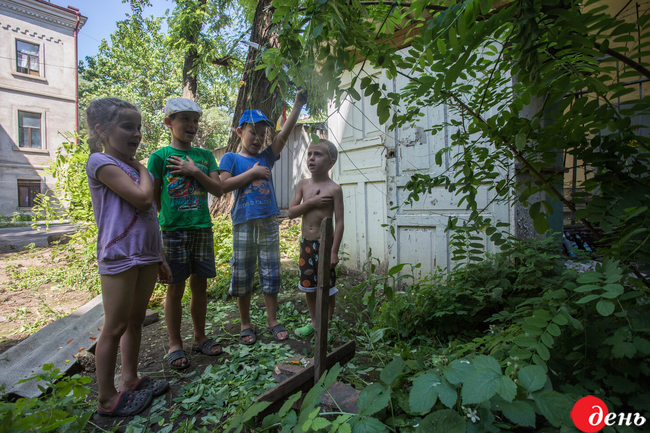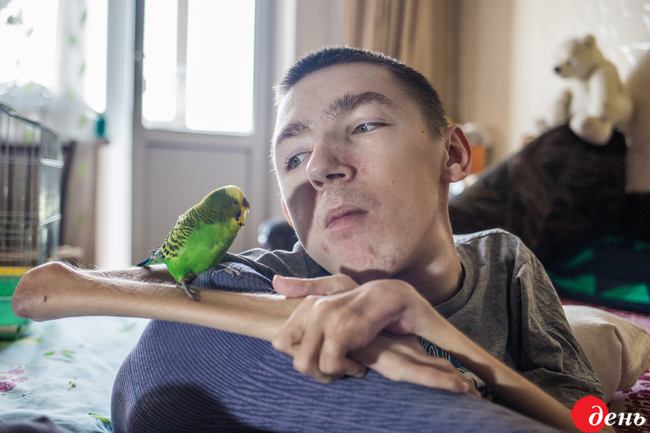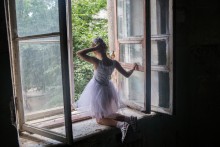“Den’s Photo Exhibition displays images which serve higher purposes,” our editor-in-chief Larysa Ivshyna aptly described in an interview the annual fall aesthetic and intellectual “marathon” of this newspaper. Apart from the fact that eye-catching photos are indispensable “allies” of newspaper contributions, we traditionally gather under one “roof” the “optics” of the country in the shape of its most meaningful photos for the past year. One can see this “sip of oxygen” and “extract” of fresh ideas for the “global overcoming” of the depression and negativity, also called the 19th Den’s International Photo Exhibition at the Lavra Gallery (1, Lavrska Street, Kyiv). The entrance is free.
In the context of this grand event, we talked with the competition’s participant Oleksandr Khomenko, the head of photo service in the online publication Depo.ua and a photographer with 10 years of experience. “I started taking pictures in 2007,” he told The Day about the beginning of his journey in photojournalism. “I bought myself an amateur camera and began to shoot everything at all and in any way I liked. Then I began to study the composition, color, history of photography. The photographer must be erudite, that is to say, possess not only technical knowledge, but also that of humanities. I am still a reporter photographer, but I am more interested in doing thematic materials than news. These unending protests, gatherings, rallies... It is fun to shoot them when you are still training and learning to do reports. You compare your photos with those made by more experienced people, and learn from it. At some stage it becomes more interesting to work by yourself.” The Day asked Khomenko to tell us the stories and “subtexts” behind colorful pictures which he had submitted for the competition this year.
THE PRINCESS DRESS AND... THE WORLD AROUND US
Your photo of an internally displaced girl in a ballroom dress who is sitting on a window sill is profoundly expressive. The picture concentrates in itself several moods at one, including both warm hope and tense anxiety. What is the story of this image?
“On that day, the internally displaced persons (IDPs) held a small festival for their children. They organized an exhibition of drawings, games, and invited friends who had a machine for making sweet wool. The children were extremely glad, they played in the courtyard, performed bold acts. I had known one of the girls, Iryna, her family came from Toretsk (formerly Dzerzhynsk), where her father worked as a miner. She put on what was apparently her favorite dress, because I had seen her more than once wearing it. The little girl ran around in that dress in the courtyard all the time, playing with others, that is, behaving as if she wore ordinary clothes. In the end, I realized the contrast at a certain moment – how much her princess dress was contrasting with the setting, with the conditions in which she lived. I tried to ‘catch’ the moment in the context as I realized how interesting the image was. And this photo near the window is one of those taken during such a ‘photo hunt.’

“By the way, the photo of a girl in a ballerina attire and that of children over the grave of a hedgehog were taken in one location, but at different times. These IDPs live in a semi-abandoned and half-repaired building of Tsarist vintage in Odesa. The house has only power and water connections. The inhabitants will begin to experience problems due to the lack of heating soon. I visited these people for the first time last December and lived with them for three days during the worst of the freeze. It was more difficult to live at 10 degrees Celsius below zero in Odesa than I had thought. I am not choosy at all about my living conditions, but even this was a test. When you go with someone through adversities, it is very unifying and trust-building. I was sitting in the courtyard at my laptop then, while children were playing. Then they approached me and said that they had found a dead hedgehog and wanted to throw it out. I suggested to bury it instead. After some time, I heard the Ukrainian anthem sung in children’s discordant voices with mistakes and twists in the lyrics. The children performed the anthem above the grave of a hedgehog! For me, this photo is very valuable because it shows the future. These are children from the Donbas, they saw the war and know what it is like – to have no home of their own. While aged merely five or seven, they know what the Motherland is. During that stay, I lived with them for two or three days, and this was the best photo I made at that time. But even that is a lot.”
SEE THE ESSENCE OF A PHOTO
Another one of your photos is deeply emotional as well, I mean that of an unusual volunteer. That powerful gaze of a wheelchair-bound boy who, despite his illness, tirelessly fundraises for others. How did you manage to take this picture with a serious social subtext?
“This boy is named Anton Dubyshyn, his story and personality have impressed me very much. He is persistent, strong-willed, and charismatic in his own way. I came to his home in the company of a female journalist to record an interview. I like to make portraits. And most of all, I like to portray people not during a conversation, but in static, situational moments. Then you can see the emotion of a person, ‘read’ the image in the picture.

“Dubyshyn keeps a parrot in his room. And during the interview, the bird was freely flying around the room, and our subject periodically spoke with it. Their communication was very lively and immediate. And again, at a certain moment, I intuitively understood how extraordinary the picture was. The essence of this photo is in the bird and the hand of the boy. This hand is so thin – it associatively reminds me of a tree branch. It is such a parallel between images of nature and human power. Although, when you press the shutter button, you cannot rationally explain what got you interested. Understanding comes after the fact when you look through the pictures. You just react to your feelings, to the moment you need to record.”
“THE PHOTO COMPETITION REQUIRES REFLECTING ON THE STORIES”
I would call the strength of the human personality the main emphasis in the pictures you submitted for the photo competition. In your opinion, what is the mission of a photojournalist?
“It is to find stories that would overcome the indifference of people to what surrounds them, ‘open’ their eyes to the essential matters, and awaken their interest. It is always interesting for me to go beyond the limits of my own comfort space and try to pull others out of it. Such an understanding of one’s goals contributes to the development of oneself as a person and a professional.”
You participate in Den’s photo competition for the third year in a row. What has it become for you, and what is its significance in your opinion?
“The level of photos displayed at the annual photo exhibition of your newspaper is very high. Firstly, even making a selection of photos for the competition became an opportunity for myself to see what interesting things I had done in the year. I select them very carefully, first 40 photos, and then 20 best ones out of them. And this is not just a search for colorful pictures from different folders on a computer, it requires reflecting on the stories. Secondly, this is a great opportunity to get an evaluation and a reaction, to understand how valuable your photos are. For a photographer who wants to develop oneself, it is critically necessary and pleasant to apply for such competitions, where one can compete with others, watch the results of the selection, compare one’s works with those of others. In this way, one begins to understand the trends of photojournalism and photo art in this country, self-improves and explores the world. I thank Den for the photo competition!”








